Hair transplants have become a popular solution for individuals experiencing hair loss. This surgical procedure involves transferring hair from thicker parts of the scalp or other body parts to the thinning or balding areas.
The effectiveness of hair transplants varies, with 10% to 80% of transplanted hair growing back within 3 to 4 months. The cost of this procedure ranges from $4,000 to $15,000, influenced by factors such as the extent of the procedure, surgeon expertise, and chosen technique.
Understanding the true cost of hair transplants requires examining additional expenses beyond the initial price, including medications and follow-up appointments.
Key Takeaways
- The cost of hair transplants varies widely based on numerous factors.
- Additional expenses include medications, follow-up appointments, and potential time off work.
- Effectiveness and recovery time are crucial considerations beyond the initial cost.
- Alternative options should be evaluated to determine if a hair transplant is a worthwhile investment.
- Costs differ between countries, procedure types, and clinics.
Understanding Hair Transplants
Understanding the process of hair transplantation is crucial for those considering this surgical option. A hair transplant is a complex procedure that requires a thorough understanding of the underlying principles and techniques involved.
What Is a Hair Transplant?
A hair transplant is a minimally invasive surgical procedure designed to treat hair loss by relocating healthy hair follicles from a donor area of the scalp to the balding area using skin grafts. This procedure is primarily used for patients with androgenetic alopecia, also known as pattern hair loss. Modern hair transplant techniques have evolved significantly, moving from noticeable “plug” techniques to sophisticated microsurgical procedures that create virtually undetectable results.
Who Is a Good Candidate?
Patients with androgenic alopecia who have fairly advanced hair loss are good candidates for a hair transplant. The ideal candidate typically has sufficient donor hair, stable hair loss, and realistic expectations about outcomes. As one expert notes, “The success of a hair transplant depends largely on having enough viable donor hair follicles.”
| Candidate Characteristics | Description |
|---|---|
| Pattern Baldness | Patients with androgenetic alopecia |
| Sufficient Donor Hair | Adequate hair follicles for transplantation |
| Stable Hair Loss | Hair loss should be stable, not progressive |
Types of Hair Transplant Procedures
Hair transplantation has evolved to include various techniques, with two primary methods standing out: Follicular Unit Transplantation (FUT) and Follicular Unit Extraction (FUE). Understanding these procedures is essential for individuals considering hair restoration.
Follicular Unit Transplantation (FUT)
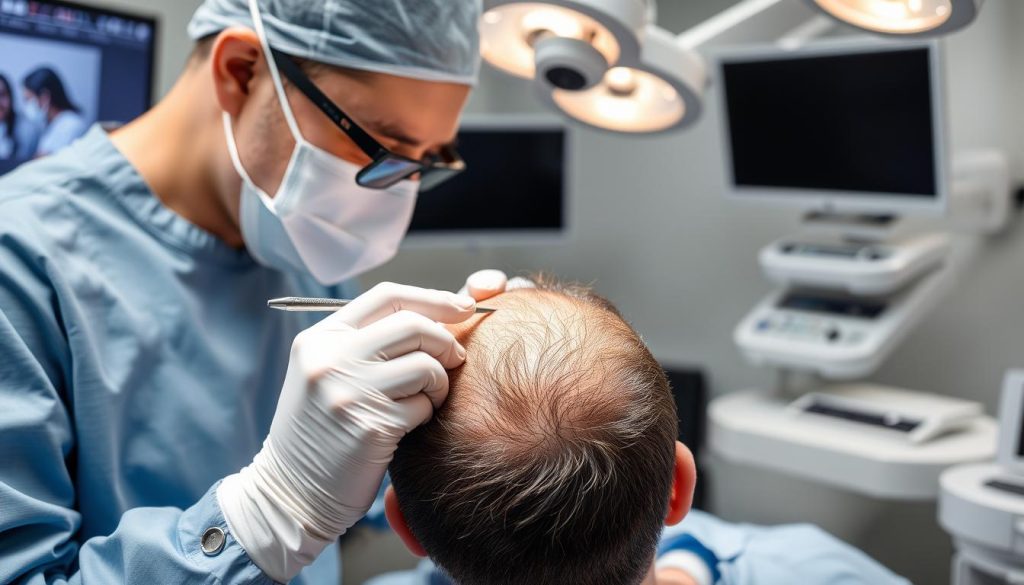
Follicular Unit Transplantation (FUT) involves removing a strip of scalp from the back of the head, typically 6-10 inches long, from which individual follicular units are harvested before being implanted into the recipient areas. This method, sometimes called the “strip method,” leaves a linear scar at the donor site that can be concealed by surrounding hair. The FUT procedure is performed manually by skilled surgeons.
The harvested strip is then separated into smaller pieces with a scalpel, resulting in as many as 2,000 grafts, some containing only one hair each. This technique allows for a significant number of grafts to be transplanted in a single session.
Follicular Unit Extraction (FUE)
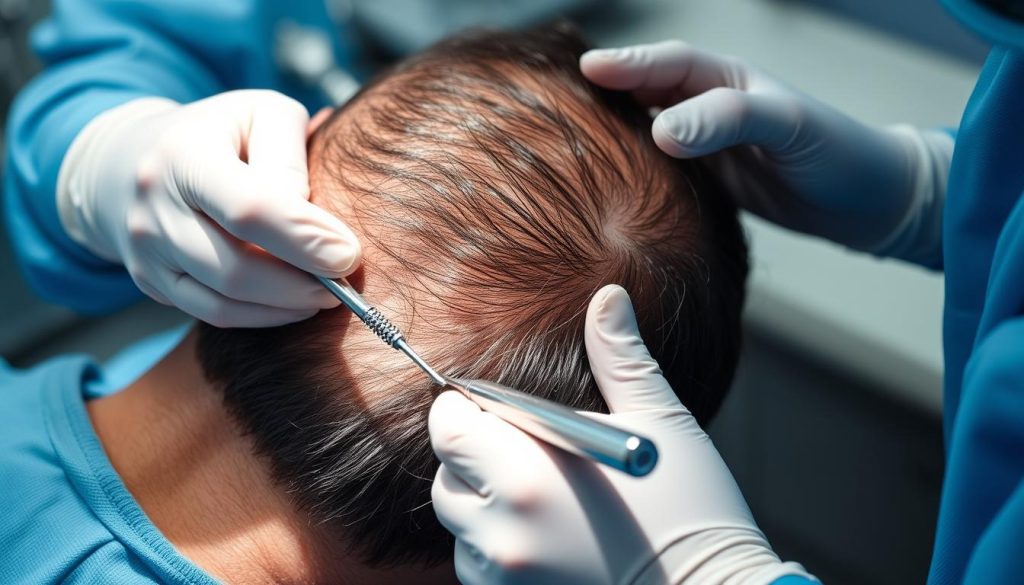
Follicular Unit Extraction (FUE) is a more modern technique that involves extracting individual follicular units directly from the scalp using a small punch tool, eliminating the need for a strip of tissue to be removed. FUE typically results in minimal scarring, offers a quicker recovery time, and allows patients to wear shorter hairstyles without visible scarring.
Both FUT and FUE procedures can be performed manually or with the assistance of advanced technologies like ARTAS (robotic system) or Neograft (automated FUE system), enhancing the efficiency of graft harvesting. The choice between FUT and FUE depends on factors including the extent of hair loss, donor hair availability, and patient preferences regarding recovery time and potential scarring.
How Much Does a Hair Transplant Cost in the US?
The cost of hair transplants in the US varies widely, influenced by several key factors. Hair restoration procedures are among the most expensive in the world, with costs reflecting the complexity of the procedure, the expertise of the surgeon, and the technology used.
Average Cost Range
The average cost for a hair transplant in the US can range from $4,000 to $15,000. For a standard procedure involving 2,500 grafts, the average total cost is approximately $13,610. Clinics like Bosley, a leading hair restoration provider, charge between $6,000 and $12,000 for complete procedures, often including comprehensive aftercare services.
Premium pricing is often associated with experienced surgeons and advanced facilities, contributing to the higher costs in the US compared to many international options.
Cost Per Graft Breakdown
The cost per graft in the US varies significantly, with Follicular Unit Transplantation (FUT) grafts ranging from $2 to $10 each, and Follicular Unit Extraction (FUE) grafts typically costing between $5 and $10 each. The average cost per graft is approximately $5.44, with prices varying from as low as $2.80 to as high as $10.50 per graft depending on the clinic and region.
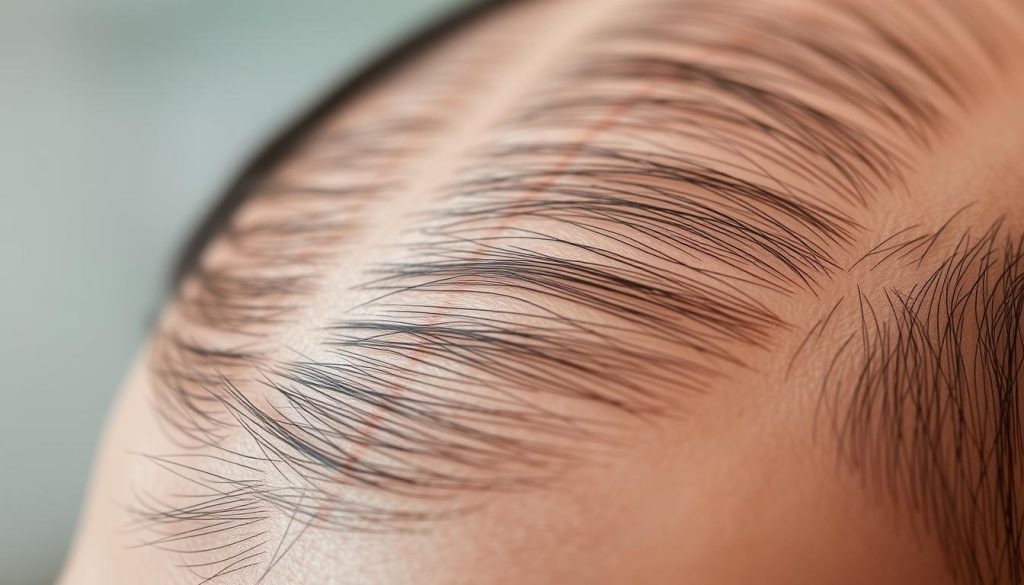
Most US clinics structure their pricing based on the number of grafts needed, with many offering package deals or sliding scale pricing where the per-graft cost decreases as the total number of grafts increases.
6 Factors That Influence Hair Transplant Pricing
Understanding the factors that affect hair transplant pricing is crucial for potential patients. The cost of a hair transplant can be influenced by several key elements, making it essential to consider these factors when planning for the procedure.
Geographic Location
The geographic location of the clinic or surgeon significantly impacts the cost of a hair transplant. Procedures in countries like the US, Canada, and Australia tend to be more expensive than those in Turkey, India, or Mexico due to differences in labor costs, facility expenses, and regulatory requirements.
Surgeon Experience and Reputation
The experience and reputation of the surgeon directly correlate with the cost. Highly skilled surgeons with proven track records and specialized training typically charge premium rates compared to less experienced practitioners.
Transplant Method
The chosen transplant method dramatically affects pricing. FUE procedures generally cost 30-50% more than FUT procedures due to the increased time, skill, and precision required for individual follicle extraction. Advanced technologies like ARTAS robotic systems or Neograft automated FUE also increase procedure costs.
Number of Grafts Needed
The number of grafts needed is a straightforward pricing factor. Most clinics charge on a per-graft basis, meaning patients with more extensive hair loss requiring more grafts will face higher overall costs.
Facility Fees and Additional Services
Facility fees and additional services such as pre-operative consultations, post-operative medications, follow-up appointments, and specialized aftercare packages can add significant amounts to the base procedure cost.
- Geographic Location: Costs vary significantly across different countries and regions.
- Surgeon Expertise: More experienced surgeons charge higher fees.
- Transplant Method: FUE is generally more expensive than FUT.
- Number of Grafts: More grafts result in higher costs.
- Advanced Technologies: Robotic or automated systems increase costs.
- Additional Services: Pre-operative and post-operative care add to the overall cost.
Hair Transplant Costs Around the World
For those considering hair restoration, understanding the global landscape of hair transplant costs is essential. The cost of hair transplants varies significantly across different countries, influenced by factors such as geographic location, surgeon expertise, and the technique used.
Cost Comparison by Country
A comprehensive study comparing prices from over 90 clinics across 11 countries revealed a significant range in hair transplant costs. Canada had the highest average cost at $17,500, followed closely by Australia at $13,751.25. In contrast, Turkey offered the most competitive pricing at $2,675.61 on average.
The average cost per graft in Turkey was found to be $1.07, making it an attractive option for international patients. Other countries like India, Mexico, and Hungary also offered competitive pricing, with average costs ranging from $3,201 to $3,650.
Medical Tourism for Hair Transplants
The dramatic difference in hair transplant costs has fueled a booming medical tourism industry. Countries like Turkey have become hubs for hair restoration procedures, offering comprehensive packages that include flights, accommodation, and transportation.
When considering international options, patients must weigh the significant cost savings against factors like language barriers, follow-up care logistics, and varying regulatory standards. However, for many, the savings on procedure costs outweigh the additional expenses associated with travel and accommodation.
The global hair transplant market continues to evolve, with more clinics and countries entering the scene. As the industry grows, it’s likely that costs will continue to vary, offering patients a range of options to choose from based on their budget and preferences.
FUT vs. FUE: Cost Comparison
When considering a hair transplant, understanding the cost difference between Follicular Unit Transplantation (FUT) and Follicular Unit Extraction (FUE) is crucial. Both procedures have their advantages and disadvantages, which are reflected in their pricing.
Costs Associated with FUT Hair Transplants
FUT is generally considered the more affordable option for hair transplants. The cost per graft for FUT can range from $2 to $10 in the US, with total procedure costs starting around $12,000 for a standard treatment. In the UK, the price per graft is typically around £4, with average costs totaling £8,000 or more. The lower cost of FUT is due to its more efficient harvesting method, allowing surgeons to extract multiple follicular units from a single strip of scalp, thus reducing procedure time and labor.
Costs Associated with FUE Hair Transplants
FUE, on the other hand, is more labor-intensive and typically costs more than FUT. The cost per graft for FUE can range from $5 to $10 in the US, with total costs often 30-50% higher than comparable FUT procedures. In the UK, FUE grafts are priced around £5 each, potentially totaling £10,000 or more depending on the patient’s requirements. Despite its higher cost, FUE offers advantages such as faster recovery time, minimal scarring, and the ability to wear shorter hairstyles without visible linear scars.
When comparing FUT and FUE, patients should consider not just the upfront cost difference but also factors like recovery time, long-term aesthetic results, and personal preferences regarding scarring. FUE’s benefits may justify its higher cost for many patients, making it a worthwhile investment in their appearance and confidence.
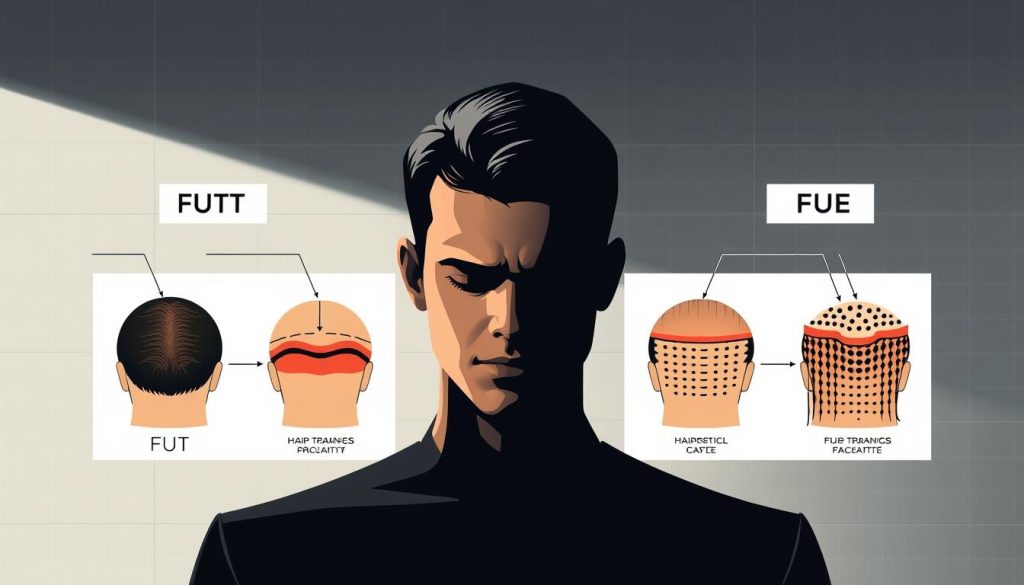
Advanced Hair Transplant Technologies and Their Costs
Advanced hair transplant technologies, including robotic systems, are changing the landscape of hair restoration. These innovative methods offer enhanced precision, potentially leading to more natural-looking results and reduced recovery times.
Robotic Hair Transplants (ARTAS)
The ARTAS system represents a significant advancement in hair transplantation technology. It utilizes a robotic arm to assist in the Follicular Unit Extraction (FUE) process, enhancing precision and consistency. ARTAS procedures typically cost between $7,000 and $18,000, reflecting the sophisticated technology and potentially more consistent results.
Neograft Automated FUE
Neograft is another advanced technology that automates the FUE process. It uses pneumatic pressure to extract follicular units gently and consistently. Neograft procedures generally range from $5,000 to $15,000, positioning them between traditional manual FUE and fully robotic ARTAS procedures in terms of pricing.
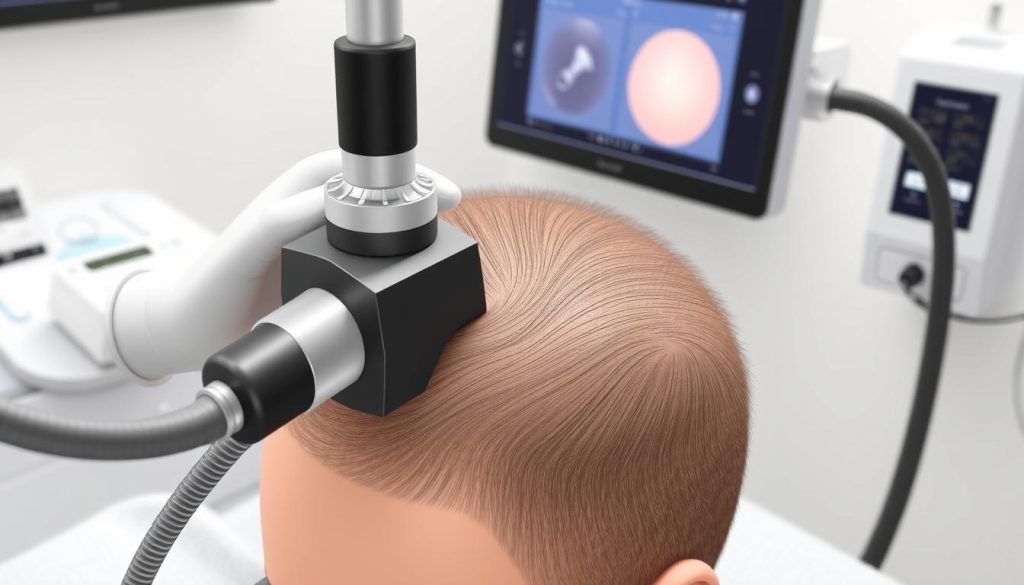
Both ARTAS and Neograft technologies offer potential benefits, including reduced procedure time and increased graft survival rates. However, the significant cost premium requires careful consideration of whether these benefits justify the additional expense. Patients should evaluate not just the technology but also the experience of the operating surgeon, as skilled medical professionals are crucial to achieving optimal results with these advanced systems.
Does Insurance Cover Hair Transplants?
Generally, insurance policies have specific exclusions for cosmetic procedures like hair transplants. This means that in most cases, individuals will need to finance their transplant procedure themselves.
When Insurance Might Cover the Procedure
In rare instances, insurance may cover hair restoration if hair loss is due to trauma, burns, or certain medical treatments. Patients must provide substantial documentation proving medical necessity for insurance to consider covering the procedure.
Financing Options and Payment Plans
Many hair transplant clinics offer financing options through third-party medical financing companies like CareCredit, Alphaeon Credit, or Prosper Healthcare Lending. These plans allow patients to spread payments over 6-60 months. Clinics may also offer in-house payment plans with interest-free financing for 6-12 months or longer payment terms with competitive interest rates.
When insurance coverage is denied, patients can explore Health Savings Accounts (HSAs) or Flexible Spending Accounts (FSAs) as potential tax-advantaged methods to pay for hair transplant procedures using pre-tax income.
Recovery and Additional Costs to Consider
The cost of a hair transplant doesn’t end with the procedure itself; there are several other expenses to consider during the recovery phase. Understanding these additional costs is crucial for patients to budget effectively and minimize financial stress.
Post-Procedure Medications
After a hair transplant, patients are often prescribed various medications to manage pain, prevent infection, and reduce swelling. These may include pain relievers like ibuprofen, antibiotics, and anti-inflammatory drugs. The cost of these medications can range from $20 to $50 for antibiotics, $10 to $30 for pain medications, and $15 to $40 for anti-inflammatory drugs. Specialized shampoos recommended for post-procedure care can add another $20 to $50 to the total cost.
Follow-up Appointments
Follow-up appointments are a crucial part of the recovery process, typically occurring at one week, one month, and three months after the transplant. While some clinics include these visits in their package price, others may charge between $100 to $200 per visit. Patients should clarify these costs when consulting with their surgeon to avoid unexpected expenses.
Time Off Work
Most patients require 3 to 7 days off work following a hair transplant, with Follicular Unit Transplantation (FUT) procedures generally requiring longer recovery periods than Follicular Unit Extraction (FUE). This time off can result in potential income loss, which should be factored into the total hair transplant cost. Additionally, patients may need to consider costs for specialized recovery supplies, such as protective headwear and sun protection, which can add $50 to $150 to the overall expense.
It’s also important for patients to be aware of potential complications, though rare, which can necessitate additional treatments or medications, creating unexpected costs. By understanding these factors, patients can better prepare financially for their transplant and recovery.
Alternative Hair Loss Treatments and Their Costs
Alternative hair loss treatments provide a range of choices for individuals looking beyond hair transplant surgery. These alternatives can be more affordable and effective for people experiencing early to mid-stage symptoms of pattern hair loss.
Medication Options
Minoxidil and Finasteride are two commonly used medications for hair loss. Minoxidil is FDA-approved for both men and women, costing $20-$50 monthly. Finasteride, costing $30-$100 monthly, is FDA-approved for men only.

Non-Surgical Procedures
Platelet-Rich Plasma (PRP) Therapy is a non-surgical option that involves injecting concentrated platelets into the scalp to stimulate hair follicle activity. PRP therapy typically costs $500-$1,000 per session.

Other alternatives include Low-Level Laser Therapy (LLLT) devices and topical peptides and growth factors. LLLT devices range from $300 to $1,000+, while topical treatments cost $30-$100 monthly. When comparing these alternatives to hair transplantation, patients should consider both the immediate cost difference and the cumulative expense over time.
Is a Hair Transplant Worth the Investment?
For many, the decision to undergo a hair transplant is influenced by its potential to restore confidence and improve quality of life. While hair transplants represent a significant financial investment, with costs ranging from $4,000 to $17,500, they offer a permanent solution to hair loss. The procedure’s success rate, with 10-80% of transplanted hair fully growing back within 3-4 months, and long-lasting results make it an attractive option for those seeking a lasting solution.
Ultimately, the worth of a hair transplant is highly individual, depending on personal priorities, financial situation, and the impact of hair loss on one’s life. Patients should consider their age, hair loss pattern, and willingness to commit to potential maintenance treatments when evaluating the investment.
FAQ
What is the average cost of a hair transplant in the US?
The average cost of a hair transplant in the US can range from ,000 to ,000, depending on the number of grafts needed and the transplant method used.
How does the cost of Follicular Unit Transplantation (FUT) compare to Follicular Unit Extraction (FUE)?
FUT is generally less expensive than FUE, with costs ranging from ,000 to ,000, while FUE can cost between ,000 to ,000 or more, depending on the complexity of the procedure.
What factors influence the cost of a hair transplant?
The cost of a hair transplant is influenced by several factors, including geographic location, surgeon experience and reputation, transplant method, number of grafts needed, and facility fees.
Does insurance cover hair transplants?
In most cases, insurance does not cover hair transplants, as they are considered cosmetic procedures. However, some insurance providers may cover the procedure if it is deemed medically necessary.
What are the additional costs associated with hair transplants?
Additional costs associated with hair transplants include post-procedure medications, follow-up appointments, and time off work. These costs can range from a few hundred to several thousand dollars.
Are there alternative hair loss treatments available?
Yes, alternative hair loss treatments are available, including medication options like Minoxidil and Finasteride, as well as non-surgical procedures like PRP Therapy. These treatments can be more affordable than hair transplants, with costs ranging from a few hundred to a few thousand dollars.
How long does it take to recover from a hair transplant?
The recovery time for a hair transplant can vary depending on the individual and the transplant method used. Generally, it can take several days to a week to recover from the procedure.
What is the success rate of hair transplants?
The success rate of hair transplants is generally high, with most patients experiencing significant hair growth and restoration. However, the success rate can vary depending on the individual, the surgeon, and the transplant method used.
